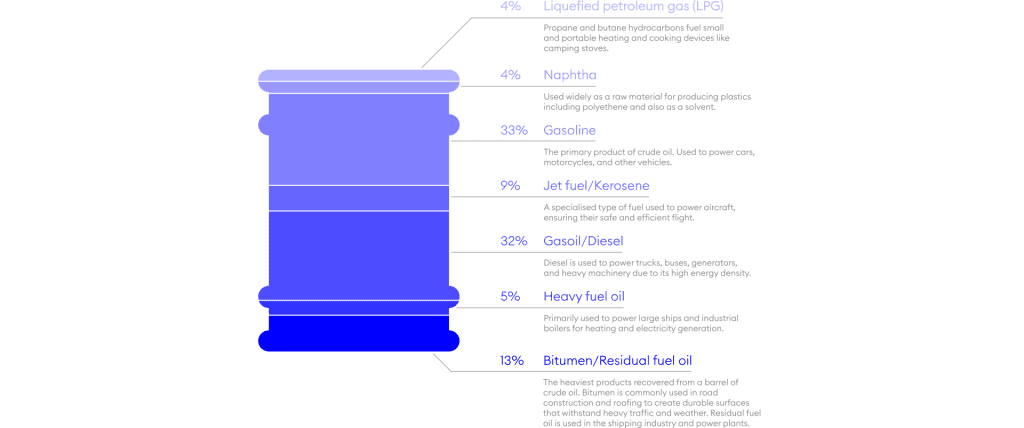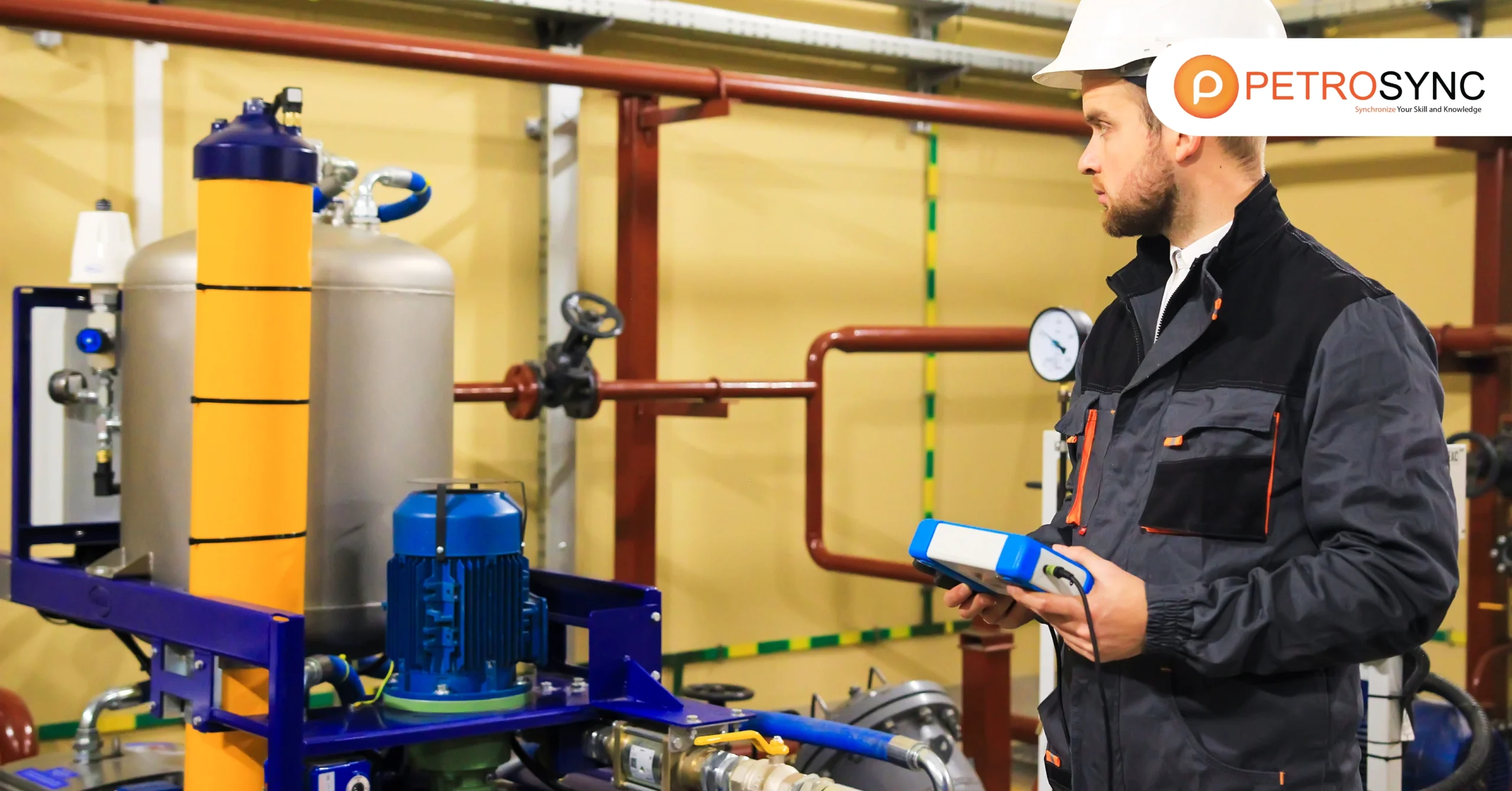When processed, petroleum becomes a range of oil and petroleum products that play essential roles in various aspects of our lives. In this article, we will dig deeper into the world of oil and petroleum products, learning about their types, uses, and significance in industry and daily life.
What Is Crude Oil?
Crude oil, a mixture of hydrocarbons that exists in liquid phase in natural underground reservoirs and remains liquid at atmospheric pressure after passing through surface separating facilities, is a natural resource found deep underground.
What Made Crude Oil?
Crude oil, formed from the remains of animals and plants (diatoms), is formed from the remains of tiny marine organisms, like plankton and algae, that lived in ancient oceans millions of years ago. When these organisms died, their remains sank to the bottom of the ocean and were buried under layers of sediment. Over time, heat and pressure from the Earth’s crust transformed these organic materials into crude oil.
Is Crude Oil Petroleum?
Yes, crude oil is a type of petroleum, but petroleum includes both crude oil and petroleum products. Crude oil is the raw, unprocessed oil itself, while petroleum refers to both crude oil and the various products derived from it through refining processes.
What Are Petroleum Products?

1. LPG (Liquefied Petroleum Gas)
LPG, which stands for Liquefied Petroleum Gas, is a type of fuel made from petroleum. It’s a mixture of propane and butane gases that are compressed into a liquid form for easy storage and transportation. LPG is commonly used for heating homes, cooking food, and powering vehicles, especially in areas where natural gas pipelines are not available. It’s widely used around the world, both in residential and industrial settings, because it’s versatile, convenient, and relatively clean-burning compared to other fossil fuels.
2. Naphtha
Naphtha is a type of petroleum product that is liquid and volatile. It is often used as a solvent in industries, like cleaning and manufacturing, because it can dissolve other substances easily. Additionally, naphtha is used as a feedstock for making various chemicals and petrochemical products, such as plastics, resins, and fibers. While it is not as widely known or used as gasoline or diesel, naphtha plays an important role in certain industrial processes and the production of various consumer goods.
3. Gasoline
Gasoline is a type of fuel made from crude oil through a refining process. It’s commonly used as fuel for cars, motorcycles, and other vehicles with internal combustion engines. Gasoline is widely used in transportation and is the primary fuel for most cars and trucks on the roads today. It’s highly flammable and produces energy when burned, powering the engine and allowing vehicles to move. Gasoline is available at gas stations and is a vital part of everyday life for many people, especially those who rely on vehicles for transportation.
4. Jet Fuel/Kerosene
Jet fuel, also known as kerosene, is a type of fuel specifically designed for use in jet engines, which power airplanes. It is a clear, colorless liquid with a high energy density, meaning it can provide a lot of energy for its volume. Jet fuel is used exclusively in aviation for commercial, military, and private aircraft. It is not widely used outside of the aviation industry and is primarily used for powering airplanes for transportation purposes.
5. Gasoil/Diesel
Gasoil, also known as diesel, is a type of fuel made from crude oil. It’s used mainly in diesel engines, which are commonly found in trucks, buses, and some cars. Diesel fuel is widely used for transportation and industrial purposes because it’s efficient and provides high torque, making it suitable for heavy-duty vehicles and machinery. Additionally, diesel fuel is often used in agricultural equipment and construction machinery. Overall, diesel fuel is widely used in various fields, especially for vehicles and machinery that require extra power and endurance.
6. Heavy Fuel Oil
Heavy fuel oil is a type of petroleum product that is thick and viscous, with a high density. It is commonly used as fuel in industrial boilers and furnaces, as well as in large ships’ engines, particularly in marine diesel engines. Heavy fuel oil is less refined than other petroleum products like gasoline or diesel, and it contains more impurities, which can lead to higher emissions of pollutants when burned. While heavy fuel oil is widely used in certain industries and applications, its usage is declining in some areas due to environmental concerns and stricter regulations on emissions.
7. Bitumen/Residual Fuel Oil
Bitumen, also known as asphalt, is a thick, sticky substance derived from crude oil during the refining process. It is commonly used in road construction to bind aggregate materials together and create asphalt pavement. Bitumen is also used in roofing materials and waterproofing products due to its waterproofing and adhesive properties.
Residual fuel oil, also called heavy fuel oil, is a thick, viscous liquid remaining after the refining process of crude oil. It is primarily used as fuel for large ships, industrial boilers, and power plants that require high-energy density fuels. Residual fuel oil is less refined than other petroleum products and contains higher levels of impurities and pollutants.
Bitumen and residual fuel oil are primarily used in specific industries such as construction and maritime transportation. While they are not as widely used as other petroleum products like gasoline and diesel, they play essential roles in their respective applications.
How To Process Petroleum into Petroleum Products?
Processing petroleum into petroleum products involves several steps in a refinery. Here’s a simplified explanation of the process:
1. Distillation
Crude oil is heated in a distillation tower, causing it to vaporize. Different components of the crude oil vaporize at different temperatures, allowing them to be separated. Lighter components, like gasoline and naphtha, rise to the top of the tower, while heavier components, like diesel and residual fuel oil, remain at the bottom.
2. Cracking
Some of the heavier components, such as long-chain hydrocarbons, are too thick to be useful as fuels. Cracking breaks down these larger molecules into smaller, more useful ones. This can be done through processes like catalytic cracking or thermal cracking.
3. Reforming
This process rearranges the molecular structure of certain hydrocarbons to produce high-octane gasoline components.
4. Treating
Petroleum products often contain impurities like sulfur and nitrogen compounds, which need to be removed to meet environmental standards. Treating involves various chemical processes to remove these impurities.
5. Blending
Different petroleum products are often blended together to achieve specific characteristics, such as octane rating for gasoline or viscosity for lubricants.
6. Final Product
After undergoing these processes, the refined petroleum products are ready for distribution and use in various applications, such as transportation, heating, and manufacturing.
In conclusion, petroleum products are essential to our daily lives, powering transportation, heating homes, and serving as raw materials for countless products. The refining process transforms crude oil into a wide range of useful substances, from gasoline and diesel to asphalt and lubricants.
While petroleum products play a crucial role in modern society, their production and use also pose environmental challenges, such as air pollution and greenhouse gas emissions. As we strive for a more sustainable future, it’s important to continue developing cleaner alternatives and technologies while also optimizing the efficiency and environmental performance of petroleum refining processes.
At PetroSync, we recognize the critical role that petroleum products play in powering the world’s economy and meeting the needs of modern society. That’s why we are dedicated to providing comprehensive oil and gas training to engineers and professionals in the industry.
Our courses are designed to equip you with the knowledge, skills, and expertise you need to excel in your roles and contribute to the efficient and responsible production, refining, and utilization of petroleum products.
By investing in professional development through PetroSync’s oil and gas training programs, you can enhance your capabilities and make meaningful contributions to the continued success and sustainability of the petroleum industry.
Credit header image: eastasiaforum

SEO specialist by day, fact-checker by night. An avid reader and content writer dedicated to delivering accurate and engaging articles through research and credible sources.






